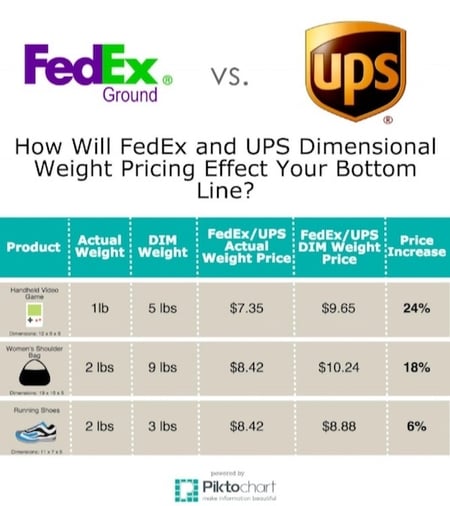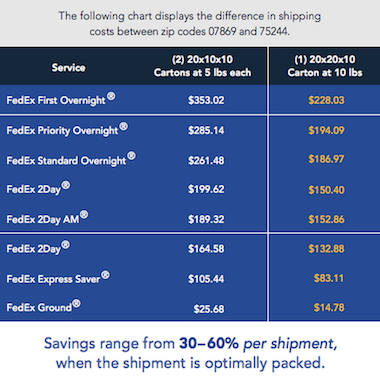Dimensional Weight Pricing
In January 2015, FedEx and UPS announced that they were shifting to a dimensional weight pricing structure for every box size. This pricing method allows carriers to account for the amount of space being used on their trucks, especially by bulky and oversized packages. Furthermore, carriers believe that dimensional (DIM) weight pricing will force retailers and customers to reduce the size of their packaging, since many e-commerce retailers are shipping lighter items in oversized packaging.Some experts predict that this may bring an additional $350 million in revenue for UPS and FedEx. ShipMatrix, which analyzed data from hundreds of millions of packages shipped from more than 50,000 U.S. locations, found that about 32% of all ground packages will be affected by the price increase, and the majority of those have an actual weight of less than five pounds.*
How Dimensional Weight Pricing Works
Prior to this shift in pricing, only ground packages measuring three cubic feet or more were subject to dimensional pricing and air packages have always been subjected to DIM weight pricing. Now all parcel packages are charged based on the dimensions of the box.
Here’s how you calculate dimensional weight:
- Measure the package in inches. If there’s a bulge, warped side, or irregular shape to your box then the manufacturer’s measurements may not apply.
- Multiply the length, width, and height to determine the volume.
- Divide by the dimensional (DIM) factor.UPS and FedEx use 166 inches for domestic ground shipments and 139 inches for international shipments. If using a different carrier, be sure to check for their specific dimensional factor.
- Round up. Make sure to round to the nearest whole number, just like the carriers.
- Know the actual weight. The carrier will charge you for whichever figure is higher: actual weight or DIM weight.
Impacts on E-Commerce
For large online retailers, dimensional weight pricing may not have an immediate impact, since they have the clout to temporarily negotiate around this new pricing structure. However, for smaller e-commerce stores there could be a dramatic increase for the cost of shipping goods. E-commerce stores that ship lightweight residential and commercial packages, such as frequently purchased home goods, will suffer the most.

Larger companies will be able to renegotiate existing contracts or grandfather in current pricing rules but what are your options as a smaller online retailer?
Solutions
- Try to negotiate a higher DIM factor with your carrier.
- Request a higher cubic feet threshold from your carrier to get a larger space allowance.
- Find the smallest box possible that best fits the item(s).
Use ShipHawk to tell you the optimal way to pack your goods. ShipHawk’s technology determines the best box for an item, to help you avoid excess dimensional weight charges. The ShipHawk API integrates directly into your shopping cart and instantly determines the price for shipping, even for items that are unpacked. Knowing the optimal way to package and ship your items will have a positive impact on your bottom line and help grow your business.

(Source: http://www.sctsoftware.com/pdf/SCT_CSO_brochure_FINAL.pdf)
*http://www.wsj.com/articles/SB10001424052702304655304579547632772245734
